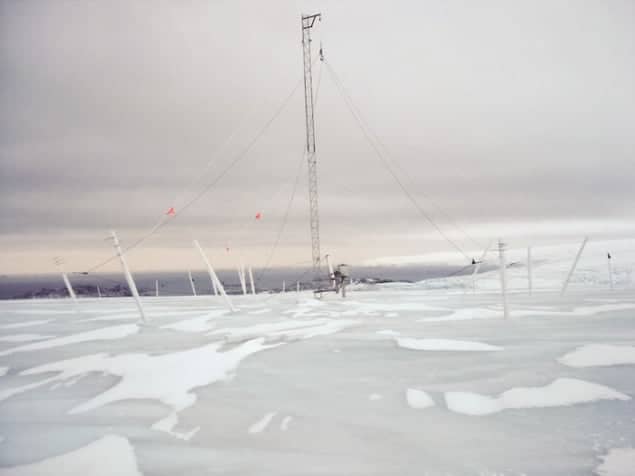
Very low frequency (VLF) radio waves can be used to measure temperatures at the mesopause – the lower boundary of the upper atmosphere – according to researchers in Israel. This new method offers a cheaper and more comprehensive way of analysing the effects of long-term climate change on the upper atmosphere, as well as more short-term phenomena, such as solar storms or thunderstorms.
At the Earth’s surface, increasing levels of greenhouse gases – such as carbon dioxide – reflect escaping infrared radiation back towards the ground. This results in a warming effect. In the upper atmosphere, however, greater concentrations of these gases have the opposite effect. At these low atmospheric densities, carbon dioxide primarily acts instead to radiate heat out to space – and does so more effectively at these altitudes than oxygen or nitrogen, the other main atmospheric components.
When the upper atmosphere cools, it also gradually shrinks – becoming denser and moving closer to the Earth’s surface. This cooling also alters the propagation paths of radio waves, which pass through the upper atmosphere.
Clear correlations
The researchers’ method works, therefore, by measuring the amplitude of VLF radio waves – which originate from navigational beacons – after they have bounced off the ionosphere, which contains the mesopause. The strength of the received signal is affected by the ionospheric density, which is in turn a product of the temperature. The team was able to observe a clear correlation between upper atmosphere temperatures – calculated from emissions from carbon dioxide measured by the TIMED satellite’s SABER instrumentation – and the amplitude of the received radio waves.
“We have found a strong anti-correlation between the intensity/amplitude of low-frequency radio waves measured in our ‘backyard’ and changes in temperature of the upper atmosphere/lower ionosphere,” paper author Colin Price, of Tel Aviv University, told physicsworld.com. “We found that a cooling/warming of the lower ionosphere (∼90 km altitude) causes an increase/decrease in the radio wave amplitude.”
This new study adds considerably to our knowledge of the temperature changes in the upper atmosphere. While the primary driver of such fluctuations is the Sun – accounting for 60–70% of the variability – it was not previously possible to systematically measure the exact nature of the remaining shifts.
Cheap and continuous measurements
Previously, direct studies of mesopause temperatures had been difficult and expensive to undertake – with the region being both too low for in situ measurement by orbital satellites, and yet too high for aeroplanes or weather balloons. The team reports that its ground-based apparatus, however, is easy to use and considerably more cost-effective – with each VLF antenna and processing computer only costing around a few thousand dollars. The new method also allows for continuous measuring of a specific region of the upper atmosphere – a task that is not possible even with indirect measurements from orbiting satellites, such as NASA’s TIMED mission.
Furthermore, the effect of greenhouse gases on the upper atmosphere is more pronounced than at ground level. Every one degree of warming in the lower atmosphere is met with a corresponding 10 degrees of cooling in the upper atmosphere. According to Price, this increased effect makes the impact of climate change easier to monitor.
More in-depth observations
“[This] discovery provides great potential of an economical approach for probing this mysterious atmosphere region in the global scale,” comments Titus Yuan, a physicist at Utah State University, who was not involved in this study. He adds that the new methodology “could enable various critical scientific topics, such as the impact of global climate change in the upper atmosphere”.
To solidify this work, the team is now looking into the possibility of taking more radio-wave observations – and for longer periods of time – from different locations around the globe. Their current study used radio stations located in Greece, Israel and New Zealand. In addition, the team is looking into comparing its results with other sources of temperature and solar-indices data.
The study is reported in the Journal of Geophysical Research: Atmospheres.



